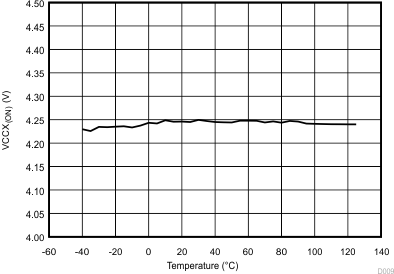SNVSAP9A March 2017 – February 2018 LM25141-Q1
PRODUCTION DATA.
- 1 Features
- 2 Applications
- 3 Description
- 4 Revision History
- 5 Pin Configuration and Functions
- 6 Specifications
-
7 Detailed Description
- 7.1 Overview
- 7.2 Functional Block Diagram
- 7.3
Feature Description
- 7.3.1 High Voltage Start-Up Regulator
- 7.3.2 VCC Regulator
- 7.3.3 Oscillator
- 7.3.4 Synchronization
- 7.3.5 Frequency Dithering (Spread Spectrum)
- 7.3.6 Enable
- 7.3.7 Power Good
- 7.3.8 Output Voltage
- 7.3.9 Current Sense
- 7.3.10 DCR Current Sensing
- 7.3.11 Error Amplifier and PWM Comparator
- 7.3.12 Slope Compensation
- 7.3.13 Hiccup Mode Current Limiting
- 7.3.14 Standby Mode
- 7.3.15 Soft Start
- 7.3.16 Diode Emulation
- 7.3.17 High- and Low-Side Drivers
-
8 Application and Implementation
- 8.1 Application Information
- 8.2 Typical Application
- 9 Power Supply Recommendations
- 10Layout
- 11Device and Documentation Support
- 12Mechanical, Packaging, and Orderable Information
Package Options
Mechanical Data (Package|Pins)
- RGE|24
Thermal pad, mechanical data (Package|Pins)
- RGE|24
Orderable Information
6.7 Typical Characteristics
At TA = 25ºC, unless otherwise noted
| VIN 8–18 V | EN = 12 V | 2.2 MHz |
| VOUT 5 V | FPWM |

| EN = 12 V |

| VIN 6–18 V | EN = GND |

| VCC Rising | EN = 12 V |

| VCC Rising | EN = 12 V |

| VIN = 12 V | FB = VDDA | EN = 12 V |

| VIN = 12 V | EN = 12 V | OSC = VDDA |

| VIN = 18 V |

| VIN = 12 V |

| VIN 8–18 V | EN = 12 V | 2.2 MHz |
| VOUT 5 V | DEMB |

| VIN 8–18 V | EN = 0 V |

| VIN 8–18 V | EN = 12 V |

| VCC Rising | EN = 12 V |

| VIN = 12 V | EN = 12 V |

| VIN = 12 V | EN = 12 V | FB = GND |

| VIN = 12 V | EN = 12 V | OSC = AGND |

| VIN = 3.8 V | VOUT 3.3 V |

| VIN = 12 V |